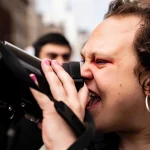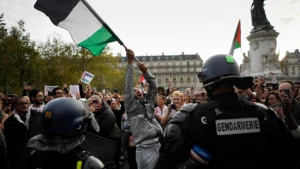British film director Steve McQueen has returned to screens with Small Axe, a series of made-for-television films that explore the West Indian community in London in the 1960s and 70s. The first film in this series, Mangrove, recounts the real-life story of the Mangrove Nine, in which nine Black protesters in London were arrested and charged with inciting a riot in 1970. The protest was called to show solidarity against the constant police raids on the Mangrove restaurant, a popular gathering spot for Carribean immigrants. The trial was notable for the ways that the defendants challenged the racist criminal “justice” system, including two of them opting to defend themselves, frequent challenges to procedure, and the fact that they demanded an all-Black jury so as to have a “jury of their peers.”
Mangrove is split into two parts, with the first focusing on the lead-up to the protest and the second focusing on the trial itself. Throughout the film, every actor turns in remarkable performances, and McQueen, with co-writer Alastair Siddons, has constructed a very watchable and powerful film. However, Mangrove does, at times, fail its radical subject matter in an attempt to appeal to a liberal audience.
Similar to his Oscar-winning film 12 Years a Slave, McQueen is uncompromising in showing white supremacist violence against Black characters. However, just as in that film, Mangrove’s graphic violence against its Black characters raises important questions about who the true audience of the film is. Film critic Jourdain Searles wrote that “[12 Years a Slave] scratches a certain itch for white viewers rooted in graphic depictions of Black pain and despair. Through their viewing they are granted an image of the other, and through the projection of the other’s pain, a white audience may feel like they gain an understanding of racism.” This same criticism can be made of Mangrove.
The first half of the film is defined by brutal and lengthy attacks on various Black characters — some named, some not — by the police. These scenes are typically counterposed with scenes of the Black characters singing, dancing, and having a good time in their own community before the white police officers come in and brutalize them. The point that McQueen is clearly making here is that these characters, who stand in for the Black community at large, are just trying to live their lives but are constantly being prevented from doing so by the police. This is, of course, completely true. However, it does raise the important question of who McQueen thinks his audience is that he has to show scene after scene of Black characters being brutalized in order to get his point across.
In this sense, Mangrove seems to be aimed at not only a white audience but also one that is unaware of police violence on communities of color. In one interpretation of Mangrove, Searles’s critique that McQueen “scratches a certain itch for white viewers rooted in graphic depictions of Black pain and despair” rings true here too. In this reading, Mangrove is a brutal performance of Black pain and trauma that allows the “good” white audience at home to pat themselves on the back because, now they truly understand Black pain and hate those types of racists (without ever questioning the racist system that we live under).
In another interpretation, however, Mangrove’s intentions could be more positive. As we have seen every time another Black person is murdered by the police, the inherent violence of our system does have to be shoved into people’s faces in order for them to understand. It seems unlikely that that so many people would have taken to the streets without the horrific video of George Floyd’s murder. So, perhaps, McQueen is simply aware of the unfortunate need to shock audiences into caring. In this reading, the frequency of the attacks show how common and oppressive police harassment is for Black communities. This allows the on-going pain and trauma that Black people are subjected to by the racist system of capitalism to stay in the forefront of a film that could otherwise devolve into another run-of-the-mill historical drama.
These questions about intent and audience dominate the first half of the film. For example, in an early scene, we see the police officers who act as the primary antagonists playing cards with a new recruit who is portrayed more sympathetically than the others but, thankfully, is never given a redemption arc. The new recruit throws down a card and the other police officers stand up, announcing that because the new recruit has played the Ace of Spades, it is now his task to go arrest the first Black person he sees. This level of outrageous racism in the police force is certainly accurate, but as a moment in a film, one could argue that it allows the audience to make a differentiation between the characters on screen and the system at large. In other words, by having the police officers be so explicit with their own racism, the audience is allowed to write them off as individual racists rather than tools of a racist system.
This is not to say, of course, that police officers are not racists. They are. However, the core issue with the police and race is not the individual feelings of individual officers but, rather, the nature of their role in preserving and defending the white supremacist system of capitalism. One reading of this scene is that McQueen is tacitly letting the system off the hook. The white liberal viewer, who is appropriately shocked by such explicit expressions of racism, can write the cops off as a few “bad apples” rather than question the system as a whole.
However, on the other hand, one could interpret this scene as McQueen attempting to make concrete what are often abstract conversations about systemic racism in the police force. The ways police target Black communities is both institutional (through specific laws and policies) as well as operational (in the way that the police enforce the laws). In this sense, showing the informal “training” of a new recruit to brutalize Black people is a concrete and all too real depiction of the ways that all police officers are inducted into the racist system of policing. Looking at the scene from this perspective, McQueen could be trying to show the audience the ways in which this process happens. For some, this could serve to make explicit the ways policing works. To support this interpretation, later in the film, we see a literal army of police officers in riot gear attacking protesters. They are completely homogenous, and it is hard to distinguish the cops; they are in total operational (and presumably philosophical) unity against the protesters. In this sense, to borrow the metaphor of British playwright Sarah Kane, we see that the cops playing cards to see who should target Black people is the seed, and the beating of protesters in the street by an army of riot cops is the tree.
Another choice that McQueen and his collaborators make is to split the focus of the film between several different characters. On the one hand, this allows for a fuller picture of all the different people who caught up in the case, but on the other hand, it has the effect of shifting the focus away from political activism. While Darcus Howe (played by Malachi Kirby) and Altheia Jones-LeCointe (played by Letitia Wright) emerge as the central figures when they defend themselves in court in the second half of the film, they take a background role to Frank Crichlow (played by Shaun Parkes) for the first half. Crichlow is portrayed as being relatively apolitical compared to Jones-LeCointe and Howe, who are both members of the British Black Panther Party. While there are some scenes focusing on their activism — including one powerful scene where Jones-LeCointe gives a speech to a group of South Asian workers about the power of the working class — the first half of the film mainly follows Crichlow’s attempts to run his restaurant in the face of constant attacks from the police. This focus comes a little too close to suggesting that the solution to racism is Black people opening small businesses.
This is a valid artistic choice, but it runs the risk of shifting the focus away from resistance to victimhood — just as McQueen does in 12 Years a Slave with slavery and in Hunger with an Irish activist going on hunger strike in prison. Throughout his career, McQueen both wants to make important political points but also wants to show the brutality that oppressed people are subjected to. The balance between these two goals can sometimes bring the political content of his work in on itself. One could easily read the first half of Mangrove as trading a story of heroic resistance to attacks for a series of scenes of Black people being brutally victimized by the police.
This somewhat tennous balance between resistance and victimhood can also be seen in the second half of the film, where it seems almost accidental, with Jones-LeCointe and Howe deciding to represent themselves almost on the spur of the moment. In addition, defendant Barbara Beese (played by Rochenda Sandall) is portrayed as almost a caricature of a radical. She constantly shouts out obscenities, seems to have no understanding of the pragmatic realities of her situation, and is constantly having to be calmed down by her heroic white lawyer. In real life, Beese was a Black Panther and a frequent contributor to the journal Race Today. Mangrove largely de-politicizes her into yet another stereotype of the “angry Black woman.” This, along with the other portrayals of the activists involved, pays disservice to the actual political convictions and strategy of the people involved.
There are, however, certainly points in Mangrove’s favor as a political work. As previously mentioned, an early scene with Jones-LeCointe shows clearly why the politics of multiracial working class solidarity are vital. In addition, the inclusion of legendary Black marxist C.L.R. James in a few early scenes helps situate the film within a lineage of leftist politics — though the film largely neuters James who is a film-worthy figure in his own right.
One of the most powerful scenes in the film features the protest which sparks the court case in the second half. For anyone who participated in the Black Lives Matter uprisings this summer, the scene felt almost like a documentary. McQueen’s striking visual style and brutal staging serves the film well here as the viewer follows a protest that is quickly surrounded by armies of police who escalate and attack the protesters. This is one of the scenes that hits the closest at what the police actually are: servants of the oppressive state. The “bad apples” narrative is largely gone as we see cop after cop beating, arresting, and tormenting protesters. It is terrifying, enraging, and all-too-familiar, all in equal measure. This is the moment that the film truly comes alive.
The court scenes in the second half are the meat of the film, and McQueen and the actors portray them spectacularly. From the dismissive judge, to the condescending prosecutors, to the defense attorneys trying to get their clients not to question the racist nature of the system, these scenes form the most coherent critique of the system that Mangrove offers. On a purely cinematic level, they are also the most engaging moments of the film, and it leaves you cheering when Howe is able to tear apart the police officers on the stand.
Perhaps the greatest point in Mangrove’s column is that it brings the story of the Mangrove Nine into the public eye. As both the United States and the UK saw massive uprisings against police violence this year, it is important to remember that these are not new struggles. The fight against the police and the white supremacist system of capitalism that they protect has been going on for generations, and we should take inspiration and lessons from the activists who have fought this fight before us.











